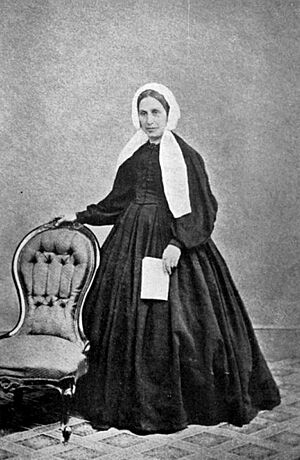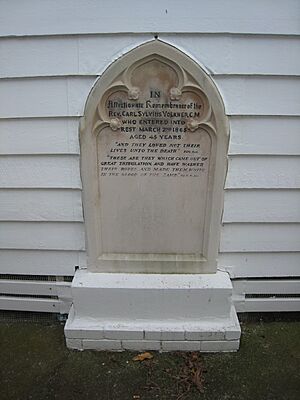Carl Sylvius Völkner facts for kids
Quick facts for kids
Carl Sylvius Völkner
|
|
|---|---|

Carl Sylvius Völkner
|
|
| Born | c. 1819 |
| Died | 2 March 1865 (aged 45–46) |
| Cause of death | Hanging |
| Burial place | Hiona St Stephen's, Ōpōtiki |
| Spouse(s) | Emma Völkner née Lanfear |
Carl Sylvius Völkner (born around 1819 – died March 2, 1865) was a Christian missionary from Germany. He worked in the North Island of New Zealand in the mid-1800s. He is known for an important event called the Völkner incident. This happened when he was killed at his church in Ōpōtiki by members of the Pai Mārire faith. This event was a key part of the New Zealand Wars.
Carl Völkner's Life
Carl Völkner was born in Kassel, a town in Germany, around 1819. He studied to become a missionary in Hamburg. In August 1849, he arrived in New Zealand. He was sent by the North German Missionary Society to work in Taranaki.
In 1852, Völkner started working for the Church Missionary Society (CMS). He married Emma Lanfear in 1854. Emma was the sister of another CMS missionary. For several years, Carl worked as a teacher in the Waikato area. In 1857, he became a New Zealand citizen.
Völkner became a deacon in the church in 1860. The next year, in August, he became a priest. He then took charge of the CMS mission station in Ōpōtiki. The local Māori tribe there was Te Whakatōhea. Soon, a church and a school were built in the area.
The Völkner Incident
In 1864, Carl Völkner noticed that some Christian teachers from Ōpōtiki had joined a Pai Mārire (also called Hauhau) group. This group was involved in fighting. Völkner traveled to Auckland in 1864 and again in January 1865. While he was away, members of the Te Whakatōhea tribe warned him not to come back to Ōpōtiki.
Völkner did not listen to the warning. He returned to Ōpōtiki on March 1, 1865. When he arrived, he was captured by Pai Mārire followers. Their leaders were Patara, a chief, and Kereopa Te Rau, a Pai Mārire prophet. The very next day, Carl Völkner was killed by members of his own Whakatōhea congregation. Another missionary, Revd Thomas Grace, was also captured but was later rescued.
When George Grey, the Governor of New Zealand, heard about Völkner's death, he was very angry. He called the people responsible "fanatics." In September 1865, he declared martial law in the Bay of Plenty. This meant the military took control. Grey ordered the people of Ōpōtiki to help the government forces. If they refused, their land would be taken away.
When Grey's soldiers landed in Ōpōtiki, they fired at the local people. This forced them to run into the nearby forest. Instead of chasing them, the soldiers took things from the Māori village (pā) and then burned it down.
Mokomoko was one of the people thought to be responsible for Völkner’s death. He surrendered in Ōpōtiki. He believed that if he surrendered, the Te Whakatōhea tribe would not be punished. However, he and four other men were arrested for murder. They were tried in Auckland. The rope used to kill Völkner was used as evidence. All five men were sentenced to death. Mokomoko and the others were executed on May 17, 1866. Many years later, in 1988, Mokomoko's remains were returned to the Whakatōhea tribe. In 1992, he was officially pardoned, meaning he was forgiven for the crime.
Kereopa Te Rau, another leader involved, ran away after Grey sent troops to the Bay of Plenty. He hid for five years. In 1871, he was captured by kūpapa (Māori who supported the government) led by Ropata Wahawaha. Kereopa was tried for Völkner's murder in Napier on December 21. He was found guilty and executed on January 5, 1872. He was also pardoned much later, in November 2014.
Legacy
The Anglican church in Ōpōtiki was renamed St Stephen the Martyr on November 21, 1875. This was done to remember Carl Völkner's death. His Bible, chalice (cup), and paten (plate) are still kept at the church. After the people involved in Völkner's death were pardoned, the church was renamed again. On June 5, 1994, it became Hiona St Stephen’s.
Some rocks in the sea, called Te Paepae o Aotea, are also known as the Volkner Rocks. They are named after him.
See also
- Völkner Incident
- Christianity in New Zealand



